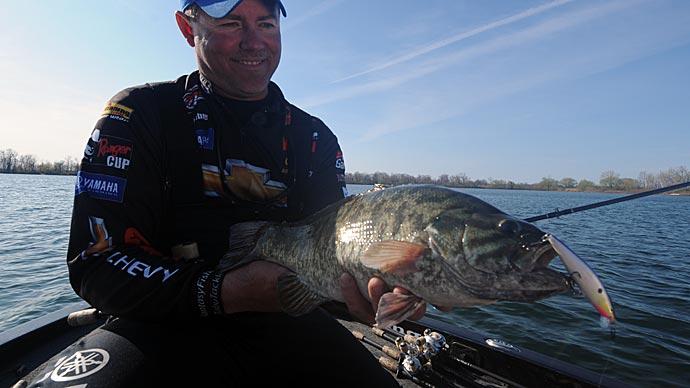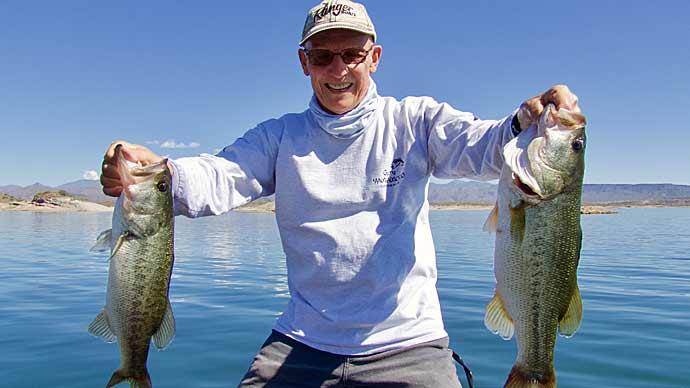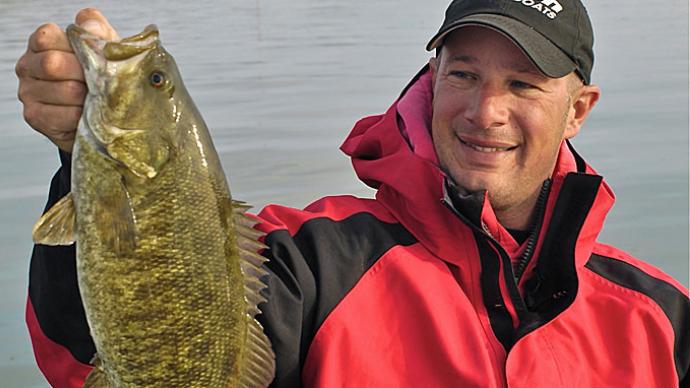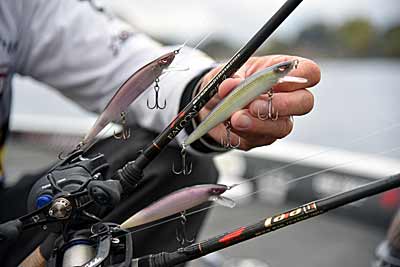
Getting a chance to sit down with Mike McClelland, I knew what we would talk about before we even got started. The topic of this interview was going to be about stickbaits, but not just stickbaits in general. We were going to go deep into the stickbait subject. I want to thank Mike for revealing so much in this article.
Tuning Your Stickbaits
When do you think it's time to grab a stickbait? Mike replied, “You should pay attention when you should be throwing a stickbait. Many anglers underestimate the time frame for throwing a stickbait. Many anglers think that the stickbait is a bait that should be thrown in Spring, then take your stickbait box out of the boat. That should change. A stickbait is a bait that can catch bass all season long if given a chance.
To start, you need to know what your stickbait is doing. That is the first thing I do besides figuring out what stickbait I want to throw. I have picked my bait and have it on the end of my line. I will take that stickbait and throw it 5ft from the boat. Is the bait slowly sinking or floating? You want your stickbait SLOWLY sinking; you don't want it floating. If your bait is floating, there are a few things that you can do to the bait before you put Storm Suspend Dots or Strips on it.
Your first option is to adjust your stickbait. You can go up one hook size, starting with the center hook first. For example, if the bait comes with size six hooks, you can go up to size four one-by-one; center first, front next, then back last. Your goal is to get your bait to sink slowly, but you want to keep the bait sitting level in the water column along the way also.
If you need to get more aggressive with your adjustments, go from light wire hooks to heavy wire hooks. Another option is to upsize your split ring or double up your split rings. Once you have exhausted these options, you can add Suspend Dots or Strips if need be.
After each adjustment to your bait, make a short cast alongside the boat to see what your adjustments to the bait did. Keep adjusting until you get the bait dialed in. Please note just because you dialed in your bait one day doesn't mean that you won't have to make adjustments again the next day. Changing water temps will affect the bait differently, so you need to go through this drill every time you're going to fish a stickbait”.
Equipment Choices
The next category we talked about was line choices. Mike's first line choice used to be monofilament, but that line choice has changed in today’s environment. With the advancement of today’s fluorocarbon lines, Mike uses Sunline Crank FC as his first line choice now for stickbaits because of the line characteristics. But Mike adds, “I will still use mono in certain conditions, and one of these conditions is if the water is frigid. I often switch back and forth to see how the bait acts in the water conditions I'm fishing.
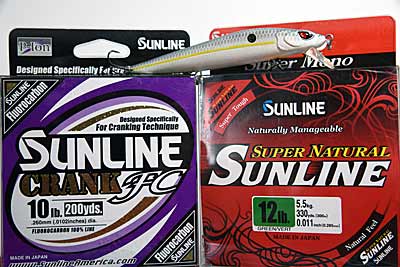
I have been known to use 8lb test when I need to get the stickbait to the deepest point I can get it to, but I have also used 14lb to keep the bait above the cover to trigger bites.
I will mainly keep one rod with mono and another with FC on the deck of my boat early in the season to adjust to the conditions that I'm faced with every day when on the water. For example, if I'm fishing my stickbait on FC and feel the bass take a swipe at the bait, but I miss the fish a couple of times, I will put the FC rod down and grab a rod that has mono on the reel. This change is because the mono line has more stretch so that the bait won't be as active, and the fish can zero in on the bait better as it's not moving as far when I twitch the bait in my cadence. This will help the bass zero in on the bait when sluggish in cold water temperatures.
On the other hand, fish a mono-spooled reel if you need to get your bait up higher in the water column because mono floats. If I can reach the depth that the bass are holding with mono, I will use that to keep the bait in the bite zone longer as fluorocarbon line sinks and may take it out of the strike zone the longer it sits there because of its characteristics.
On the other hand, if I need to get the bait down deeper in the water column, I will use a reel filled with fluorocarbon because of its line sinking characteristics.
Use these different line characteristics that each line has to your advantage to get you more bites and keep your bait in the strike zone longer”.
Let’s touch on reels also. Mike fishes all his stickbait fishing with a Bass Pro Qualifier Reel in a gear ratio of 5:6.1. Mike says, “You want to use a lower speed reel to help you slow down when fishing a stickbait early in the season. This works two ways. It helps you slow down when you're fishing the bait and helps you when you hook a lightly hooked bass. Putting too much pressure on a hooked fish with a faster gear ratio reel many times can result in a lost fish working the bass back to the boat in cold water conditions”.
Mike uses his signature Falcon signature rod 6’8” MH for fishing sticks.
Cadence Of Your Stickbait
In water temps below 50 degrees, make your cast and reel your stickbait down with 8 to 10 turns of your reel, then stop. Let the bait sit to a 6 to 10 count (1-1,000 2-1,000 etc.) in between, give the bait two twitches, then start your count again. If you don't get any bites, you may want to lengthen your pauses until you get a bite, then remember what your cadence count was to reenact that retrieve again.
Mike says, “As the water warms up, you can get more aggressive with your retrieve, but start slow and work your way up to less time between twitches and pause times."
Pick Your Sticks
You have a lot of stickbaits so pay special attention to what you're fishing as there is a variety of good stickbaits on the market. Mike is the top angler behind his SPRO McStick line of baits. The main baits in that lineup are the McStick 95, 110, and 115. The 110 is the gold standard that many of the stickbaits on the market used as their bait pattern. The depth of the 95 and the 110 will get down to 3-5ft. When the bass get on a smaller forage bite, grab the McStick 95 to match this smaller baitfish size.
When faced with bass in the shallows, the McStick 115 will be your stickbait of choice as this bait has a limited depth of 0-3ft. This is an excellent bait to throw when the bass get on a bed or when fishing over shallow weeds, stumps, or cover.
When the bass are deeper coming out of winter haunts, you will need to grab a McRip 85. This bait has a running depth of 8 to 10ft. You can get this bait a little deeper if you play with hook size as well.
Mike says, “The biggest key when fishing stickbaits is to keep your bait above the bass you're targeting. If your stick is at the same level or below, bass often can't see the bait. Keep your bait in the zone above the bass to have your best chance of triggering them to bite”.
Mike alluded to a few new McStick’s coming soon. He was in the final testing stages of testing a new stickbaits in the pattern of 110+ and 110+2. Keep your eyes open for these baits coming to the end of your lines in 2022.
Mike adds, “Don't be too quick to take your stickbait boxes out of your boat. Many think that when the Spring period is over, the time to throw a stickbait is over. I throw stickbaits all season as long as the bass are in the zone I can reach with a stickbait. One of the biggest reasons for this is no one else is throwing stickbaits after early Spring. My stickbait many times is the only stickbait they see any more”.
Forward-Looking Sonar
Knowing that Mike is one of Garmin’s National Pros and has had an extended time using and helping Garmin develop the Live Scope platform, I asked Mike how valuable of a tool is this forward-looking sonar. Mike’s reply was, “I have used my Live Scope to help me dial in my baits. I can get a look at what my baits are doing in deeper water, better than I was able to before I got Live Scope. I can also see how the bass are reacting to my bait. It also helps me dial in on how the bass want the bait daily and with every retrieve. As I'm making my retrieve, I can see how the bass reacts to the bait. Am I making the right retrieve? Do I need to add more action to my bait, or do I need to tone down the action? I can see these results right in front of me as it's happening. It is a tool every bass fisherman should have on the front of his boat. I can say flat out it will help you catch more bass during your time on the water”.


